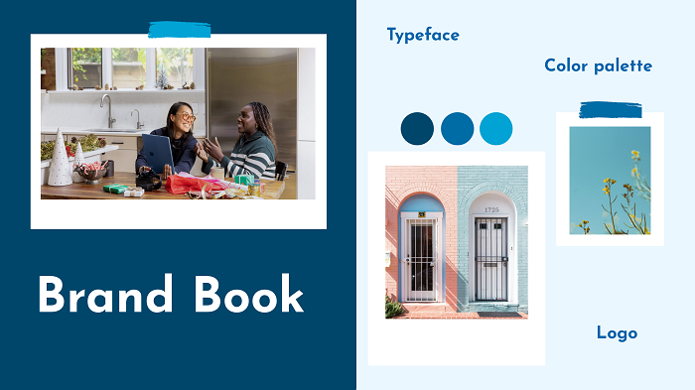From Nike's famous 'swoosh' to Mastercard's converging circles, branding is something that every consumer on Earth has seen and experienced before. But what goes into creating a recognizable brand? Typically there’s more to it than meets the eye.
In this post, we'll take a closer look at the branding process, why it’s important, and how developing a brand book—or brand guidelines—can help shape a company's identity.
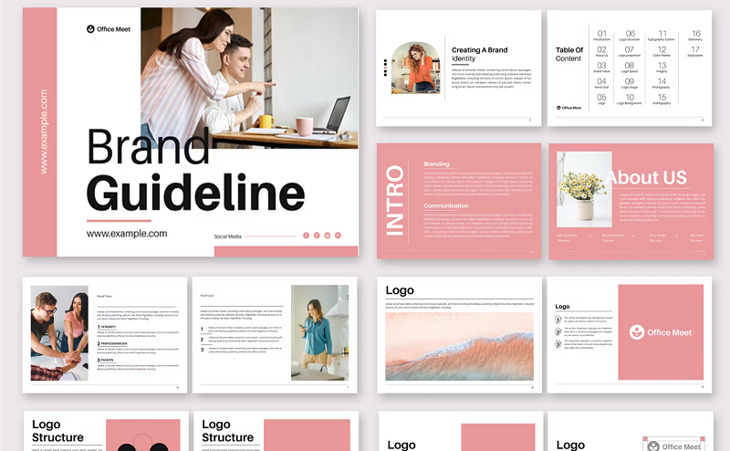
Source: Envato Elements
What Is Branding and Why Is It Important?
By definition, branding refers to the act of promoting a product or business with distinctive advertising. The practice of branding first took hold of modern marketing in the early twentieth century through pioneering brands, such as Coca-Cola, Colgate, Ford Motor Company, Chanel, and LEGO, who set themselves apart with iconic logos and design elements that remain instantly recognizable today.
Things have changed; branding is now a complex process involving multiple stages of discussion, consideration, and planning. Modern companies rely on it to create their own identity within increasingly-crowded markets, which makes the right branding strategy fundamental to success. Let’s go through a few examples:
"The quicker picker upper"
"You're in good hands"
"Eat fresh"
Sound familiar? If so, by identifying slogans from Bounty, Allstate, and Subway, you've just proven why branding is a valuable part of today's marketing landscape. Companies can stand out from their competition by creating a clear identity and emotionally connecting with their customers.
Research suggests that young Americans recognize over 400 logos and that nearly half of them base their purchasing decisions on brand familiarity. This is why companies pour so much money into their branding efforts; it pays off.
What Is a Brand Book?
A brand book is a set of guidelines that define and control a brand's identity. Also known as style guides, they provide information on everything from the company's visual identity and logo design to its mission statement, core values, and even the tone of voice that should be used in corporate communications or collateral.
The main purpose of a brand book is to showcase and explain your brand’s identity, mission, visual style, and core values. Your brand book will help customers and staff clearly understand what you want to portray to your audience. Once you create the first version, you can reevaluate it every 5–7 years, depending on how your brand evolves.

Source: Envato Elements
Brand Book Examples
Brand books can seem like a business-minded, dull formality at face value. After all, who wants to read a collection of rules? However, the truth is, brand books shouldn’t be uninspiring. In many cases, they are the opposite of boring, and they allow companies to express their fun side at full throttle.
Take Ben & Jerry's as an example. The iconic ice cream company created a colorful brand book that showcases the ins and outs of their marketing guidelines with a healthy portion of personality.
The brand itself is playful across its communication, and its brand guidelines are no exception. This brand book is full of witty copy, puns, and Woody, the brand’s iconic cow.
Want to create an interactive brand book?
Urban Outfitters is also a good example of an unconventional and fun design. The brand book offers a creative approach to what the brand should look like in various media.
Overlapping visual elements resembling a scrapbook combined with a grid pattern gives a 90s look, which makes this book perfect for its Millennial target audience.

Source: Urban Outfitters
How to Create a Brand Book
Any company that wants to stay relevant in today’s market should know that brand books are an essential, non-negotiable asset. It's not a question of whether you should create a brand book, but how.
While the process can vary from situation to situation, creating a brand book generally involves the following fundamental steps:
- Define your audience: Who are they? What do they like? How can your company present itself to them in an appealing way?
- Establish core values: These are the key tenets that will serve as the base of your company identity—who are you as a company, and what do you believe in?
- Create a visual identity: What should your logo look like? How can you use color, fonts, and other design elements to convey your core message?
- Write your story: What overall narrative will guide your brand? Are you a fun-loving company or a serious business?
Best Practices for Designing a Brand Book
No two brand books should ever be the same—the whole point is to create an identity that's unique to your company.
That said, there are certain best practices that all companies should keep in mind when designing their own brand book or style guide. These include:
- Be concise and straightforward
- Be generous with the space between elements and across pages
- Provide examples, illustrations, and product mockups
- Remain consistent with colors and fonts throughout
- Include an explanation of visual elements
- Leave room for growth as the company changes over time
Key Components of Your Brand Book
So, what content should go into your brand book? Like the communication tool Slack demonstrates in the example below, everything should be broken down on a component-by-component basis.
1. The Cover
Like in any other book, the cover is your brand guide's first and best chance of making a good impression on an audience (i.e., your team and collaborators). Design your brand book cover with that in mind and make sure to cover key information in a friendly and simple tone. Also, show basic information about your brand, including these elements:
- Company name
- Company logo
- Title of the book
- Date published
2. Content Guide
People don’t like wasting time trying to find what they're looking for—ensure readers don't have to by adding a content guide or a table of contents page. This page should include a high-level breakdown of everything they can expect to find inside the brand book.
This table of contents can be interactive and clickable, appearing in a sidebar or at the top of the site. The idea is to make navigation around the brand book efficient and user-friendly.
3. Your Brand’s Name and History
Story time! This is where you begin to invite readers in by introducing the company's origin story, mission statement, and core values. Keep it brief and informative, but give them a reason to believe.
Telling people how your brand became a reality is a great opportunity to catch their attention. To make your visual storytelling even more enjoyable, you can use different formats to talk about your brand’s history, such as:
- Timeline
- Images
- Videos
- Quotes
Frito Lay, for example, has everything on their website: history, logos, brands, and downloadable material.

Source: FritoLay
4. Logo
Logos are considered the most recognizable symbols of a brand. Be sure to dedicate at least one page of your book to explain your logo's history, usage, and variations.

Source: Envato Elements
5. Color Palette
Your brand's color palette will be the most frequently used visual element in your marketing. Include the exact RGB and HEX codes to be used accurately and consistently.
Having a defined color palette is helpful for your design and marketing teams and for external contributors or contractors that help you create assets for your brand. This palette must be consistent across your brand materials to strengthen your brand identity. This way, your brand will stand out in the marketplace and differentiate from competitors.
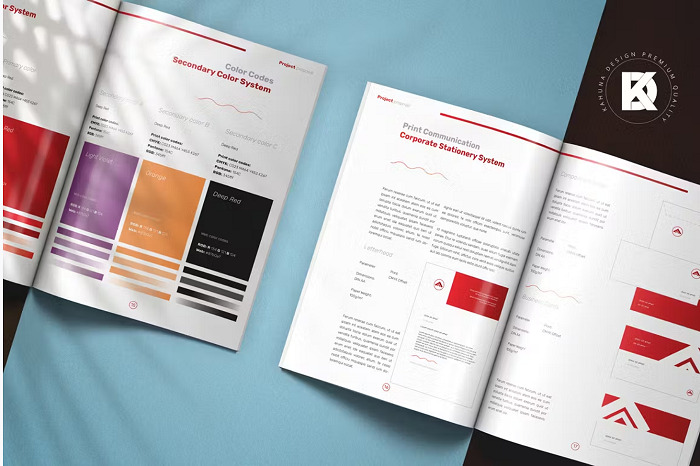
Source: Envato Elements
6. Typography
Fonts are how you communicate your message —pick the wrong one, and readers may misinterpret your content. Make sure to include examples of various typefaces available to your brand to help designers choose the right one for any given situation.
This part of your brand book should include typography specs such as:
- Fonts and font families
- Proportions and sizes
- Spacing
- Capitalization
Focusing on such detailed technicalities will require effort when creating the brand book, but it will leave no room for doubt and save you from unnecessary misinterpretation.
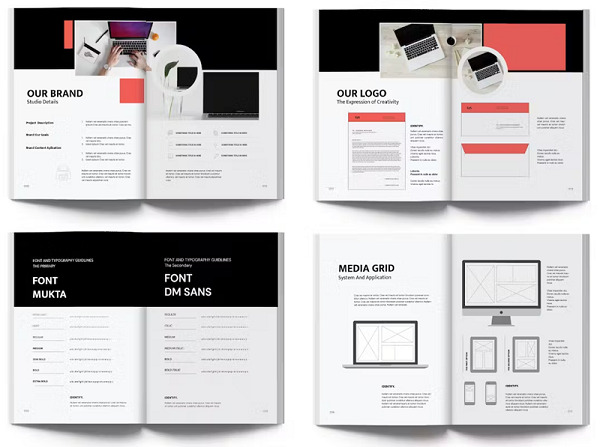
Source: Envato Elements
7. Tone of Voice
Your brand's voice is a key asset. Explain how you want your company to sound when communicating with customers, and provide examples of how to do it in different contexts.
Your tone of voice plays a key role for storytelling. Forming a deep and emotional connection with your customers will eventually lead to greater engagement.
8. Iconography
Iconography refers to using small graphical elements to communicate messages and ideas. Include visuals and examples of how to use them effectively.
Images and symbols will allow you to synthesize complex ideas and communicate without words, as well as deliver a message without compromising space.
9. Correct Use of your Brand
Outline proper guidelines on how to use your brand effectively. This includes when, where, and how to display logos, colors, tone of voice, etc.
The correct use of your branding assets will ensure that the teams in your organization–marketers, designers, and sales representatives–know how to represent your brand across multiple channels.
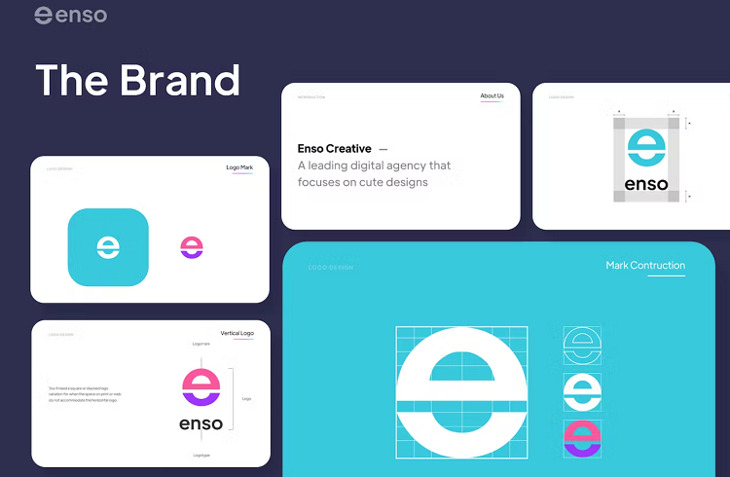
Source: Envato Elements
Brand Book Formats
Contrary to what their name suggests, brand guidebooks are rarely printed as actual books. They're usually digital, in the form of a file that’s easy to navigate and that can be shared between stakeholders and designers easily.
These formats include PDFs, websites—and flipbooks that are essentially a substitute for both. Let’s take a look at these three main options you’ll have when building a brand book.
1. PDF
Most people are familiar with PDFs. This is a commonly used file type for sharing documents in digital form and then printing. Creating PDFs has some benefits, like having the same layout to display across many devices and that it’s a compressed format.
However, one of the cons of creating a PDF brand book is that they aren’t as engaging as other formats. PDFs are rigid and not interactive; and users have to scroll and zoom in when they want to look at something in detail.
2. A Website with Downloadable Materials
Some companies decide to represent their brand through a website to showcase all their elements in a single online interface.
A website also allows users to download individual PDFs and images, such as logos and color palettes, to use in their own designs. It just takes things a step further as a live domain that can be scaled up, down, or changed as needed. But developing such a website requires a team, which may take up a lot of time and additional effort.
Here is a website-based brand book example from Starbucks. You can easily access details and more information through a content menu when navigating through it or by simply scrolling down.

Source: Starbucks' Ceative Resource website
Website-based brand guidelines are a more resource-intensive option and are best suited for companies with a lot of content to reference, like Google. You'll notice that many major companies opt to use this method because a brand book website or microsite can be incredibly effective when it comes to establishing prominence.

Source: Google's Brand Resource Center
3. Flipbooks
Flipbooks are digital publications that look and almost feel like real books, but they’re available online as direct links. A flipbook created with FlippingBook can actually be a substitute for both PDFs and websites mentioned above.
Since flipbooks are HTML5 documents created from PDFs, they’re actually considered by some people as independent websites. You can include links to downloadable materials across the pages of your flipbook, so the necessary branded content is always at hand. And a flipbook is a clear step up from a simple PDF, because it’s engaging and interactive. Embedded videos, GIFs, pop-up image galleries, and polls and quizzes across the pages of your brand book will boost audience engagement.
Create your brand book today
🎨 Brand your brand book with FlippingBook
FlippingBook allows you to brand your documents by adding custom background, your company logo, and color palette. On top of that, you can fully customize your brand book link to reinforce your brand identity, increase trust, and drive more engagement with your content.
Conclusion
The logos, colors, and messages we know and recognize are all products of brand identity. And a brand book is essential for capturing and communicating your brand’s identity to potential customers, ensuring your company's message runs consistently across all channels. With the right format and content, you can create a comprehensive and cohesive guide that will increase any reader’s understanding of your company and its values.
Good luck!
Author's bio:
Alina Midori Hernández is a journalist-turned-content producer who works at Envato. She’s passionate about copywriting and content writing, but she also enjoys poetry and reading nonfiction.
